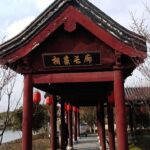Ji Zi, also known as Prince Ji, was the fourth son of King Shou Meng of the Wu State during the Spring and Autumn period. He was not only a person of noble character but also a far-sighted diplomat. The Ji Temple was constructed in later generations to honor him. Inside the temple, there are famous historical sites such as the Cross Inscription Stone, the Water Absorbing Stone, and the Ji River Bridge. However, the most famous feature is the unique spectacle of boiling springs—Geysers. The boiling wells of Ji Zi Temple are mainly distributed along the edge of the Boiling Well Pond in front of the temple. Historical records indicate that there were once a hundred wells here, some of which were boiling wells. Six ancient boiling wells still exist today, with water in three wells clear and in three muddy, each separated by a short distance. From a slight distance, the well curbs appear simple and elegant, with a unique charm; upon closer inspection, the water within the wells is churning and boiling, with rolling waves making sounds. This peculiar landscape fascinates tourists. Additionally, there are numerous boiling springs surging in the rivers and ponds surrounding the temple. As early as over 1600 years ago, during the Eastern Jin Dynasty, the boiling wells had already become famous. Visiting Ji Zi Temple and observing the boiling springs has been a highly desirable activity for officials and literati throughout the ages. Historical figures such as Li Bai, Sa Du Ci, and Shen De Qian have all left behind immortal poems and writings after visiting the temple and observing the wells. The temple is open all year round from 7:30 AM to 4:30 PM.
Ji Zi Temple
Ji Zi, also known as Prince Ji, was the fourth son of King Shou Meng of the Wu State during [&hellip[...]









